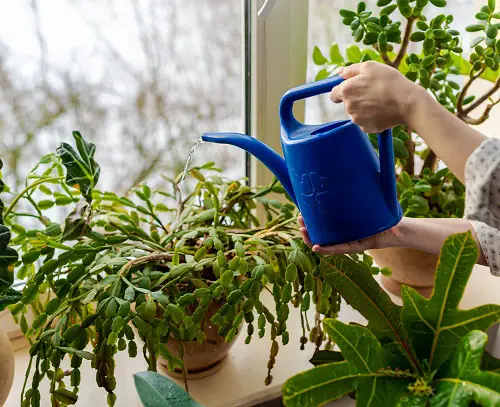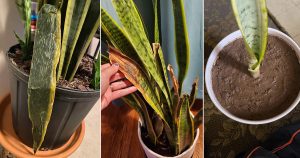Find out How to Make Your Christmas Cactus Bloom All Winter Long for a happy and colorful holiday. Six Must-know tips are coming along!

Christmas cactus (Schlumbergera bridgesii) is one of the popular holiday bloomers that bloom during the winter season. These lovely plants naturally bloom from the end of the fall season with beautiful, tubular flowers in shades of red and pink. However, here are some tricks and tips to keep these bloomers flowering all winter long that you might have never known!
When Does Christmas Cactus Usually Bloom?
In general, this holiday plant prepares to form its flower buds in November, and with proper care, the buds start to bloom from late November to January or sometimes till mid-February, depending on the region. To encourage consistent blooming, maintain a schedule for light exposure and temperature adjustments. A dark phase is important for bud formation, followed by balanced light and temperature for flowering.
Unlike desert cacti, this plant thrives in humid conditions and prefers moderate moisture. Avoid sudden changes in humidity or drafts, as these can disrupt bud formation. And, keep it away from frequently opened doors or windows during the pre-blooming phase to ensure a smooth flowering process.
How to Make Your Christmas Cactus Bloom All Winter Long
1. Play with the Light

Christmas cactus usually thrives in bright, indirect light but it hates the harsh direct sun rays because in its native habitat, it grows under the large tropical trees of the rainforest in Brazil. So, to mimic this you have to ensure it gets 12-14 hours of uninterrupted darkness each night for about 6 weeks before blooming. Cover it with a breathable cloth or move it to a dark room to trick it into thinking the days are shorter.
Once the buds appear, let it receive the indirect sunlight like the dappled sunlight rays of the jungle. The right balance of light and dark is the secret to getting your cactus those bright colorful blooms.
Note: Uninterrupted darkness means no light during this time which includes no lamp light inside the room.
2. Maintain a Good Temperature

Try to keep it cool and comfy in the daytime and let it drape in the chillier temperature (50-55 F or 10-13 C) at night during the pre-blooming stage. This drop in nighttime temperature is what convinces the plant to produce buds.
Avoid placing your plant near radiators, drafty windows or vents as these sudden changes can stress it out.
3. Watering Cycle

With this holiday cactus, forget the desert cactus rules! Christmas cactus likes moderate watering. So you can water sparingly during the dormancy, just enough to keep the soil slightly moist and then increase the watering frequency once it starts to bloom.
The key to watering your plant without drowning it in water is checking the top inch layer of the soil. If it feels dry then pour water and see that excess water drains out from the pot. Add a little rainforest ambiance by misting it occasionally or placing a pebble-filled tray with water. It will do the job of maintaining a good humidity around your plant, like giving your plant a spa day!
However, ensure that water doesn’t stagnate in the tray, as excess humidity can lead to fungal problems. Keep the surrounding area clean to discourage mold or pests.
4. Fertilizers and the Timing to Feed
Think of fertilizing your cacti as its energy drink, but the timing is everything. Feed it with a balanced fertilizer (eg. 20-20-20) every two weeks from spring to early fall. As buds begin to form, lower the fertilizing frequency because during this time it needs to focus on flowering. Avoid over-fertilization as it delays the blooming period.
Here is a tip—use a bloom-boosting formula that has a higher phosphorus ratio in early fall to give it an extra nudge toward long-lasting blooms. You can also use banana peel water to do so. For an organic alternative, try adding a small amount of compost tea or diluted fish emulsion in the earlier growing season. This can promote overall plant health and better flowering.
5. Prune and Repot

After the last blooms fade, give your cactus a makeover! Prune the stems by pinching or cutting off a segment or two to encourage branching and more flowers for the next season. It is a good haircut that results in a fuller and bushier plant.
Again, avoid repotting it too often because this cactus loves being a little root-bound. But if it has been years since its last move then repot in the spring season using a well-draining soil.
Caution: If you are planning to repot in the late fall, don’t do it! It stresses the plant and can derail your blooming goals.
6. Prevent Bud Drop

There is nothing more heartbreaking than watching your cactus develop buds only to see them drop before blooming. What can cause this? Overwatering, sudden temperature fluctuations and moving the plant too much.
Know that your Christmas cactus loves consistency so don’t change the position after the buds appear as it doesn’t tolerate new light angles. Again, avoid and keep away from overly warm spots and if buds still fall off, check the watering schedule or light exposure. If you must move the plant, do so gently and try to maintain similar lighting conditions to minimize stress on the buds.
Some Care Tips and Prep for Next Season
- Encourage more indirect light and favorable temperature conditions in your home to extend the blooming period. You can also give your plant a mid-winter boost by gently cleaning its leaves with a soft, damp cloth to remove dust. This helps it absorb light more efficiently.
- Keep up with deadheading spent blooms to have new blooms. Also, after the end of the blooming period give a light pruning for better growth and flowers the next season.
- You can also repot your Christmas cactus in the spring in a larger pot to promote more growth and give space to spread. Choose a pot that is only slightly larger than the current one, as an excessively large pot can lead to water retention issues and slower blooming.
Note: If your Christmas cactus faces any problems with blooming have a look at this article for reasons and solutions to why it is not blooming and how to get those lovely blooms back.
Hoping that reading this article has cleared your many confusions. For more suggestions and help write to us in the comment section and have a bright and colorful blooming holiday season.







